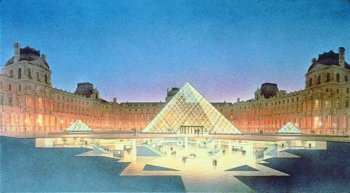
The Pritzker Architecture Prize
Kenneth Clark once told Colin Amery
that we can tell more about a civilization from its architecture than from
anything else it leaves behind. Amery, architecture critic for the London
Financial Times, repeats the statement in the catalogue celebrating the
exhibition The Pritzker Architecture Prize 1979-1999, on view in Heinz
Architectural Center November 6 through February 27, 2000.
Considered the Nobel Prize of architecture, the award was established
in 1979 by Chicago’s Pritzker family, owners of the Hyatt Hotel chain,
to honor a living architect for a distinguished body of completed buildings.
The exhibition includes photographs, models, drawings and other documentation
of projects completed by the 22 winners (two architects shared the prize
in 1988). It is the first such exhibition to bring together works by all
the laureates, and can be considered a discerning overview of the architecture
of our time.
The prize is highly regarded because of the rigorous process by which
the jury selects winners, and for its significant monetary award. Any architect
can be nominated (1988 winner Gordon Bunshaft nominated himself), but nominees
must have completed at least ten built structures. The jury of architects
and other cultural figures travels around the world to see the works under
consideration because, as juror and architecture critic Ada Louise Huxtable
commented, "the buildings can’t come to see us."

To date, the Pritzker winners include architects from twelve countries
on four continents. Their work represents a variety of styles, revealing
the pluralistic character of contemporary architecture. Featured in the
exhibition are projects by I.M. Pei, with his new entrance to and expansion
of the Louvre; Frank Gehry, whose Guggenheim Museum is drawing crowds to
Bilbao, Spain; and Renzo Piano, who is represented by the Jean-Marie Tjibaou
Cultural Center in Nouméa, New Caledonia. Also featured is the recently
completed conversion of Berlin’s Reichstag, designed by 1999 laureate Lord
Norman Foster.
Architecture is what Bill Lacy, Executive Director of the Pritzker Prize,
calls a "hybrid profession – the most scientific of the arts and the most
artistic of the sciences." By viewing these works together, visitors will
see a collection that embodies the qualities of "Firmness, Commodity and
Delight"– traits revered in architecture since classical times and stressed
in the credo of the Pritzker Prize.
Join us for the Holidays
One of Pittsburgh’s favorite holiday traditions, the towering Christmas
Trees decorated by the Women’s Committee of Carnegie Museum of Art, will
open December 2 in the Hall of Architecture. The theme of the trees this
year, Centuries Gone By, will portray decorations from five historic periods:
Celtic, Medieval, Renaissance, the Age of Discovery, and Victorian.
All of the ornaments are handmade by the committee members, after months
of research. "We really do learn a lot," says Susanne Wilkinson, Chair
of the Christmas Trees for 1999. "We chose the theme this year to celebrate
the approaching end of the millennium, and to focus on the idea of carrying
this tradition into the future." The Women’s Committee began installing
and decorating the trees over 30 years ago. The trees are on view through
January 6, 2000.
Along with the trees, the beautiful nativity scene, the Neapolitan Presepio,
will also be on view. Its more than 100 figures, made in Italy between
1700 and 1830, represent the Neapolitan concept of the nativity in a scene
of village life.
|

